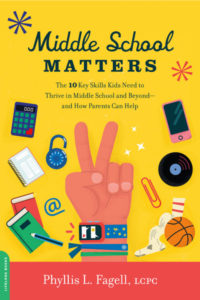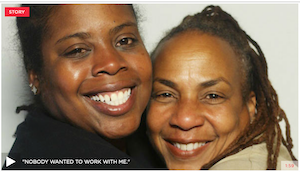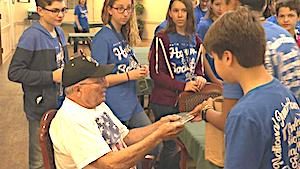10 Ways We Can Help Tweens Feel Included
 By Phyllis Fagell
By Phyllis Fagell
In seventh grade, Katie started dressing more androgynously, pairing her jeans with suit vests, ties and the occasional fedora. The comments started coming when she cut her long, blond hair short and dyed her bangs black.
“Are you gay?” one boy asked her. “What’s with the tie? Are you going on a job interview or something?” Katie (not her real name) wanted her external appearance to match how she felt inside, but she hated the attention and pulled inward. The more she stood out, the more she wanted to disappear.
It’s the great paradox of middle school. Tweens are trying to individuate at an age when any sort of difference will generate tremendous pressure to conform. They desperately crave acceptance but harshly judge others’ idiosyncrasies. They may take on a social justice issue while simultaneously waging war on a classmate over social media.
Tweens are relentlessly self-critical, their empathy is still developing, and they’re certain they’re being judged by everyone. All that insecurity can lead to insensitivity.
Providing Support, Fostering Independence
To help middle schoolers embrace “otherness,” including their own, educators need to expose them to differences, illustrate that everyone has a backstory, provide opportunities to make a positive impact, and help them boost their self-compassion.
Tweens also need help making reparations and moving forward when their efforts fall flat. It’s hard to strike that balance between nurturing a middle schooler and fostering their independence, but they need both from the adults in their lives as they toggle between childhood and adolescence.
The good news is that tweens are impressionable, eager to please, and still solidifying their values. If they learn to treat others with dignity during a phase when they’re their own harshest judge, they’ll be more likely to develop a healthy self-identity.
Authentic Inclusion: 10 Ideas
Here are 10 ways educators can help move kids from fear to understanding and promote a culture of authentic inclusion in our classrooms and schools.
1. Assign “Tiny TED” talks and essays that use the prompt, “I wish others knew.”
In her famous TED Talk, “The Danger of a Single Story,” Chimamanda Ngozie Adichie warns against the dangers of reducing someone to a stereotype. The seventh graders at my school prepare and present a mini TED talk in which they share something about their own lives, whether they feel defined by the fact that they’re adopted, or have two mothers, or were diagnosed with ADHD.
Before they write their speeches, they watch Adichie’s TED talk and read texts such as Monica Harwell’s StoryCorps narrative about what it was like (in 1991) to be the first woman to climb electric utility poles for ConEdison in New York.
To foster self-understanding, students also can write essays using the prompt, “I wish others knew….” The more they write and embrace their own narrative, the more they’ll appreciate others’ stories, too.
2. Provide mirrors and windows.
Show students images of beauty, power and intelligence that look like them. Diversify the curriculum and bring in speakers from different backgrounds to make sure everyone is seeing visual representations of themselves. Recognize the power of affinity groups, too. Tweens experience less bullying and better mental health when they explore salient aspects of their identity with others who share their experience.
At the same time, help them see that others may have a different backstory, but are not “less than.” Read fiction and nonfiction books that broach issues surrounding identity, inequity, privilege, and racial and cultural differences.
3. Talk about the power of words.
Teach students that even seemingly benign comments can be hurtful. Educators can use tools such as The Seattle Times Under Our Skin Project, which had 18 people who represent a range of backgrounds and perspectives talk candidly on video about concepts such as diversity and white privilege.
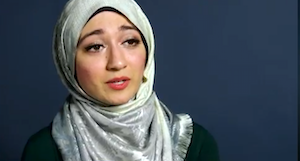
As you’re imparting these ideas, consistently call kids out when they make mean comments. Explain why their behavior is unacceptable and hold them accountable, but give them a way forward. Middle schoolers need help reflecting on hurtful incidents and making amends. If you simply criticize a child’s character, they’ll get stuck in shame.
4. Discuss divisive or upsetting events in the news.
If a disturbing event is in the news, whether it relates to anti-semitism, racism, homophobia or anything else that could emotionally affect your students, don’t ignore or dismiss it. You don’t have to have all the answers, but initiate a discussion. Otherwise, you’ll send the message that it’s not important and deprive them of the opportunity to understand the event and its impact on their friends. Most middle schoolers want to support one another and have a positive culture. Facilitate open discussion and bring any fear and bias to the surface.
As you have these talks, some kids may feel excluded because they hold unpopular viewpoints. If you squelch their opinions entirely, you’ll transmit the message that their voice is unwelcome and their feelings may bubble over in ways that hurt their peers. Instead, say, “I want to hear your opinion, but you can’t say anything that will degrade someone else’s humanity.” Set that boundary and challenge them from a standpoint of morality. Pretending that something isn’t divisive won’t make it disappear, and most kids want a positive school culture.
5. Share stories of kids using their differences in positive ways.
The Internet is full of uplifting stories that illustrate that there is strength in difference. Sanah Jivani was diagnosed with alopecia when she was 12 and wore a wig by eighth grade. After struggling with self-worth, she founded Natural Day, an international movement to end insecurity and help kids embrace the very things that make them stick out.
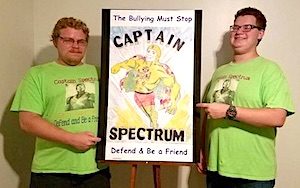
6. Be thoughtful about lunch.
Counselors and teachers can invite students to lunch in their room and encourage kids with social capital to invite struggling peers. Schools can designate one table for games for kids who feel overwhelmed or excluded, or assign seating periodically to bust cliques and push kids outside their comfort zone.
Some schools participate in events such as National No One Eats Alone Day, a Beyond Differences event that helps introduce kids to students who, for instance, are isolated and eating with an aide. Kids often need help with that first face-to-face interaction, but from there can move beyond awkwardness to genuine friendship.
7. Write classroom contracts and hold regular meetings.
At my school, each grade spends a few weeks establishing community norms, then writes and signs a class contract. We also hold periodic meetings to discuss social and ethical issues. Students lead the meetings or teachers facilitate community circles. If you take this approach, make sure the topics are kid-generated so they feel relevant.
My middle school students will pair up and write three guiding questions. One discussion centered around socioeconomic sensitivity and how a financially comfortable kid might inadvertently be insensitive to a financially struggling classmate. The students collectively agreed to suggest activities such as sleepovers rather than trips to the mall.
8. Offer service learning activities.
To heighten students’ empathy, have them identify and engage in meaningful volunteer work. They won’t develop an empathetic mindset from one-off acts of kindness, so choose projects they can stick with over time. The “why” will become ingrained, and they’ll experience the boost in self-confidence that comes from seeing they can change their own or others’ circumstances.
9. Incorporate mindfulness.
Mindfulness, which is simply being aware of your negative thoughts without judging them, is a form of self-compassion and a way to combat tweens’ merciless self-criticism. And as I mentioned, secure kids are more likely to embrace peers who are different. Both active and meditative mindfulness activities can help kids accept that no one is perfect and everyone is allowed to make mistakes.
10. Offer inclusion classes.
Inclusion is a way to challenge kids’ assumptions and teach them to more readily embrace individual differences. For the first 13 years of his life, Matthew Lager, who has nonverbal autism, had no way to communicate. In middle school, he learned to share his thoughts by typing. He delivered a speech in which he shared how hard it is to live in a defiant body and deal with bullying from people. He noted that people don’t think it bothers him because he doesn’t have the expected motor response and can’t defend himself.
“When I make an unusual noise,” he wrote, “look at me once rather than multiple times. Recognize that I hear your snickers and see your sneers.” Inclusion classes help kids understand that bullying and exclusion hurt everyone, regardless of how they seem to react.
